Tourism Development of Cultural Heritage Resources Through Conservation Concepts: A Case Study of Ningxia, China
Abstract
1. Introduction
1.1. Cultural Heritage Research at the Micro Level
1.2. Preservation Concepts in Cultural Heritage Research
1.3. Macro Level of Cultural Heritage Research
1.4. Limitations in the Current Chinese Cultural Heritage Research
2. Materials and Methods
2.1. Overview of the Study Area
2.2. Research Methodology
2.2.1. Kernel Density Analysis
2.2.2. Spatial Autocorrelation
- Global spatial autocorrelation
- Local spatial autocorrelation
2.2.3. Geo-Detector
2.3. Data Sources
2.3.1. Data on Cultural Heritage Resources
2.3.2. Basic Data
3. Results
3.1. Classification of Cultural Heritage Types Based on Conservation Concepts and Tourism Development Needs
3.2. Comparative Analysis of the Quantity of Cultural Heritage in Different Regions of Ningxia
3.2.1. The Mathematical Characterization of Ningxia’s Cultural Heritage Resources
3.2.2. The Spatial Pattern of Cultural Heritage Resources in Ningxia
3.3. Influencing Factors and Optimization Strategies for the Spatial Pattern of Cultural Heritage Resources in Ningxia
3.3.1. Selection of Influencing Factor Indicators and Model Construction
3.3.2. The Influencing Factors on the Spatial Pattern of Cultural Heritage Resources in Ningxia
4. Discussion
4.1. Recommendations
4.2. The Development Strategy for Cultural Heritage Resources in Ningxia
4.3. Comparison with Other Authors’ Research
5. Conclusions
Author Contributions
Funding
Data Availability Statement
Acknowledgments
Conflicts of Interest
References
- Shackley, M. Introduction–world cultural heritage sites. In Visitor Management; Routledge: London, UK, 2009; pp. 1–9. [Google Scholar]
- Blake, J. On defining the cultural heritage. Int. Comp. Law Q. 2000, 49, 61–85. [Google Scholar] [CrossRef]
- Ahmad, Y. The scope and definitions of heritage: From tangible to intangible. Int. J. Herit. Stud. 2006, 12, 292–300. [Google Scholar] [CrossRef]
- Melis, C.; Chambers, D. The construction of intangible cultural heritage: A Foucauldian critique. Ann. Tour. Res. 2021, 89, 103206. [Google Scholar] [CrossRef]
- Arizpe, L. Intangible cultural heritage, diversity and coherence. Mus. Int. 2004, 56, 130–136. [Google Scholar] [CrossRef]
- Zhang, J.; Wen, J.; Liu, J.; Hao, J.; Sun, G.; Gao, X. Distribution characteristics and tourism utilization modes of intangible cultural heritages in Jinzhong eco-cultural conservation area. Econ. Geogr. 2023, 43, 234–240. (In Chinese) [Google Scholar]
- Tuan, T.H.; Navrud, S. Capturing the benefits of preserving cultural heritage. J. Cult. Herit. 2008, 9, 326–337. [Google Scholar] [CrossRef]
- Throsby, D. Determining the value of cultural goods: How much (or how little) does contingent valuation tell us? J. Cult. Econ. 2003, 27, 275–285. [Google Scholar] [CrossRef]
- Salazar, S.D.S.; Marques, J.M. Valuing cultural heritage: The social benefits of restoring and old Arab tower. J. Cult. Herit. 2005, 6, 69–77. [Google Scholar] [CrossRef]
- Chen, C.S.; Chiu, Y.H.; Tsai, L. Evaluating the adaptive reuse of historic buildings through multicriteria decision-making. Habitat Int. 2018, 81, 12–23. [Google Scholar] [CrossRef]
- Armbrecht, J. Use value of cultural experiences: A comparison of contingent valuation and travel cost. Tour. Manag. 2014, 42, 141–148. [Google Scholar] [CrossRef]
- Wright, W.C.C.; Eppink, F.V. Drivers of heritage value: A meta-analysis of monetary valuation studies of cultural heritage. Ecol. Econ. 2016, 130, 277–284. [Google Scholar] [CrossRef]
- Mason, R. Be interested and beware: Joining economic valuation and heritage conservation. Int. J. Herit. Stud. 2008, 14, 303–318. [Google Scholar] [CrossRef]
- Munjeri, D. The reunification of a national symbol. Mus. Int. 2009, 61, 12–21. [Google Scholar] [CrossRef]
- Noonan, D.S. Contingent valuation and cultural resources: A meta-analytic review of the literature. J. Cult. Econ. 2003, 27, 159–176. [Google Scholar] [CrossRef]
- Báez, A.; Herrero, L.C. Using contingent valuation and cost-benefit analysis to design a policy for restoring cultural heritage. J. Cult. Herit. 2012, 13, 235–245. [Google Scholar] [CrossRef]
- Masoud, H.; Mortazavi, M.; Farsani, N.T. A study on tourists’ tendency towards intangible cultural heritage as an attraction (case study: Isfahan, Iran). City Cult. Soc. 2019, 17, 54–60. [Google Scholar] [CrossRef]
- Gómez-Zapata, J.D.; Espinal-Monsalve, N.E.; Herrero-Prieto, L.C. Economic valuation of museums as public club goods: Why build loyalty in cultural heritage consumption? J. Cult. Herit. 2018, 30, 190–198. [Google Scholar] [CrossRef]
- Safiullin, L.; Bagautdinova, N.; Safiullin, N. Historical and Cultural Heritage and Region’s Economic: Case Study Central and Eastern Russia. Procedia-Soc. Behav. Sci. 2015, 188, 151–156. [Google Scholar] [CrossRef]
- Havinga, L.; Colenbrander, B.; Schellen, H. Heritage significance and the identification of attributes to preserve in a sustainable refurbishment. J. Cult. Herit. 2020, 43, 282–293. [Google Scholar] [CrossRef]
- UNESCO World Heritage in Danger; UNESCO: Paris, France, 2020.
- Foster, G. Circular economy strategies for adaptive reuse of cultural heritage buildings to reduce environmental impacts. Resour. Conserv. Recycl. 2020, 152, 104507. [Google Scholar] [CrossRef]
- Lak, A.; Gheitasi, M.; Timothy, D.J. Urban regeneration through heritage tourism: Cultural policies and strategic management. J. Tour. Cult. Change 2020, 18, 386–403. [Google Scholar] [CrossRef]
- He, X. Theoretical Reflections on the Protection of Intangible Cultural Heritage. Jiangxi Soc. Sci. 2005, 2, 103–109. [Google Scholar]
- Quan, X.; Cheng, B. Logical Rationale and Strategic Pathway: From the Systematic Nature of Intangible Cultural Heritage to Systematic Protection. Stud. Ethn. Arts 2024, 37, 142–151. [Google Scholar]
- Winter, T. Beyond Eurocentrism? Heritage conservation and the politics of difference. Int. J. Herit. Stud. 2014, 20, 123–137. [Google Scholar] [CrossRef]
- Dai, T.; Zheng, X.; Yan, J. Contradictory or aligned? The nexus between authenticity in heritage conservation and heritage tourism, and its impact on satisfaction. Habitat Int. 2021, 107, 102307. [Google Scholar] [CrossRef]
- Dimitropoulos, K.; Tsalakanidou, F.; Nikolopoulos, S.; Kompatsiaris, I.; Grammalidis, N.; Manitsaris, S.; Denby, B.; Crevier-Buchman, L.; Dupont, S.; Charisis, V.; et al. A multimodal approach for the safeguarding and transmission of intangible cultural heritage: The case of i-Treasures. IEEE Intell. Syst. 2018, 33, 3–16. [Google Scholar] [CrossRef]
- Nakonieczna, E.; Szczepański, J. Authenticity of cultural heritage vis-à-vis heritage reproducibility and intangibility: From conservation philosophy to practice. Int. J. Cult. Policy 2024, 30, 220–237. [Google Scholar] [CrossRef]
- Trillo, C.; Aburamadan, R.; Mubaideen, S.; Salameen, D.; Makore, B.C.N. Towards a systematic approach to digital technologies for heritage conservation. Insights from Jordan. Preserv. Digit. Technol. Cult. 2020, 49, 121–138. [Google Scholar] [CrossRef]
- Veldpaus, L. Historic Urban Landscapes: Framing the Integration of Urban and Heritage Planning in Multilevel Governance. Ph.D. Thesis, Technische Universiteit Eindhoven, Eindhoven, The Netherlands, 2015. [Google Scholar]
- Wang, X. Reform of the management mode of China’s natural cultural heritage. J. Tour. 2002, 5, 15–21. (In Chinese) [Google Scholar]
- Ferretti, V.; Bottero, M.; Mondini, G. Decision making and cultural heritage: An application of the Multi-Attribute Value Theory for the reuse of historical buildings. J. Cult. Herit. 2014, 15, 644–655. [Google Scholar] [CrossRef]
- Gravagnuolo, A.; Girard, L.F.; Ost, C.; Saleh, R. Evaluation criteria for a circular adaptive reuse of cultural heritage. BDC. Bollettino Del Centro Calza Bini 2017, 17, 185–216. [Google Scholar]
- Bosone, M.; De Toro, P.; Girard, L.F.; Gravagnuolo, A.; Iodice, S. Indicators for ex-post evaluation of cultural heritage adaptive reuse impacts in the perspective of the circular economy. Sustainability 2021, 13, 4759. [Google Scholar] [CrossRef]
- Yuan, D.; Wu, R.; Li, D.; Zhu, L.; Pan, Y. Spatial patterns characteristics and influencing factors of cultural resources in the Yellow River National Cultural Park, China. Sustainability 2023, 15, 6563. [Google Scholar] [CrossRef]
- Wang, X.; Zhan, S. Exploring the Spatial Distribution of ICH by Geographic Information System (GIS). Mob. Inf. Syst. 2022, 2022, 8689113. [Google Scholar] [CrossRef]
- Nie, X.; Xie, Y.; Xie, X.; Zheng, L. The characteristics and influencing factors of the spatial distribution of intangible cultural heritage in the Yellow River Basin of China. Herit. Sci. 2022, 10, 121. [Google Scholar] [CrossRef]
- Pang, L.; Wu, L. Distribution characteristics and influencing factors of Intangible cultural heritage in Beijing-Tianjin-Hebei. Herit. Sci. 2023, 11, 19. [Google Scholar] [CrossRef]
- Cusin, J.; Passebois-Ducros, J. Appropriate persistence in a project: The case of the Wine Culture and Tourism Centre in Bordeaux. Eur. Manag. J. 2015, 33, 341–353. [Google Scholar] [CrossRef]
- Alberts, H.C.; Hazen, H.D. Maintaining authenticity and integrity at cultural world heritage sites. Geogr. Rev. 2010, 100, 56–73. [Google Scholar] [CrossRef]
- Nogué, J.; Vicente, J. Landscape and national identity in Catalonia. Political Geogr. 2004, 23, 113–132. [Google Scholar] [CrossRef]
- Zhao, L.; Liu, L. Inheritance and protection of intangible cultural heritage of traditional ethnic sports in Northwest China. Ningxia Soc. Sci. 2016, 4, 234–241. (In Chinese) [Google Scholar]
- Chang, Y.; Zhao, X.; Liu, Y. Analysis of spatial agglomeration characteristics and influencing factors of sports intangible cultural heritage in the Yellow River Basin. J. Beijing Sport Univ. 2021, 44, 137–150. (In Chinese) [Google Scholar]
- Xue, Z.; Zhu, P. Research on Red Tourism Resources in Ningxia. Ningxia Soc. Sci. 2006, 5, 100–108. (In Chinese) [Google Scholar]
- Wang, S.M.; He, Z.L.; Guo, Y.Z. Spatial differentiation and influencing factors of rural tourism model villages in the five northwest provinces of the Silk Road Economic Belt. Econ. Geogr. 2019, 39, 199–206. [Google Scholar]
- Huang, Y.; Xue, Q. Spatio-Temporal distribution characteristics and driving factors of traditional villages in the Yellow River Basin. PLoS ONE 2024, 19, e0303396. [Google Scholar] [CrossRef] [PubMed]
- Wang, Q.; Bing, H.; Wang, S.; Xu, Q. Study on the spatial distribution characteristics and influencing factors of famous historical and cultural towns or villages in Hubei Province, China. Sustainability 2022, 14, 13735. [Google Scholar] [CrossRef]
- Yu, W.; Ai, T.; Shao, S. The analysis and delimitation of Central Business District using network kernel density estimation. J. Transp. Geogr. 2015, 45, 32–47. [Google Scholar] [CrossRef]
- Park, S.B.; Kim, J.; Lee, Y.K.; Ok, C.M. Visualizing theme park visitors’ emotions using social media analytics and geospatial analytics. Tour. Manag. 2020, 80, 104127. [Google Scholar] [CrossRef]
- Cai, Z.; Zhang, Z.; Zhao, F.; Guo, X.; Zhao, J.; Xu, Y.; Liu, X. Assessment of eco-environmental quality changes and spatial heterogeneity in the Yellow River Delta based on the remote sensing ecological index and geo-detector model. Ecol. Inform. 2023, 77, 102203. [Google Scholar] [CrossRef]
- Liu, S.; Ge, J.; Bai, M.; Yao, M.; He, L.; Chen, M. Toward classification-based sustainable revitalization: Assessing the vitality of traditional villages. Land Use Policy 2022, 116, 106060. [Google Scholar] [CrossRef]
- Chen, W.; Yang, Z.; Yang, L.; Wu, J.; Bian, J.; Zeng, J.; Liu, Z. Identifying the spatial differentiation factors of traditional villages in China. Herit. Sci. 2023, 11, 149. [Google Scholar] [CrossRef]
- Xie, Z.; Yan, J. Kernel density estimation of traffic accidents in a network space. Comput. Environ. Urban Syst. 2008, 32, 396–406. [Google Scholar] [CrossRef]
- Okabe, A.; Satoh, T.; Sugihara, K. A kernel density estimation method for networks, its computational method and a GIS-based tool. Int. J. Geogr. Inf. Sci. 2009, 23, 7–32. [Google Scholar] [CrossRef]
- Baxter, M.J.; Beardah, C.C.; Wright, R.V.S. Some archaeological applications of kernel density estimates. J. Archaeol. Sci. 1997, 24, 347–354. [Google Scholar] [CrossRef]
- Yang, Y.; Wong, K.K.F. Spatial distribution of tourist flows to China’s cities. Tour. Geogr. 2013, 15, 338–363. [Google Scholar] [CrossRef]
- García-Palomares, J.C.; Gutiérrez, J.; Mínguez, C. Identification of tourist hot spots based on social networks: A comparative analysis of European metropolises using photo-sharing services and GIS. Appl. Geogr. 2015, 63, 408–417. [Google Scholar] [CrossRef]
- Moran, P.A.P. The interpretation of statistical maps. J. R. Stat. Soc. Ser. B (Methodol.) 1948, 10, 243–251. [Google Scholar] [CrossRef]
- Anselin, L. The Moran scatterplot as an ESDA tool to assess local instability in spatial association. In Patial Analytical Perspectives on GIS; Routledge: London, UK, 2019; pp. 111–126. [Google Scholar]
- Wang, J.; Xu, C. Geodetector:Principles and prospects. J. Geogr. 2017, 72, 116–134. [Google Scholar]
- Xue, Z.; Guo, Q. Urbanization and protection of traditional village cultural heritage—Taking Ningxia as an example. J. North. Univ. Natl. (Philos. Soc. Sci. Ed.) 2015, 5, 11–16. (In Chinese) [Google Scholar]
- Hu, G.; Kong, L. Intellectual property protection of intangible cultural heritage—Analysis based on Ningxia’s national intangible cultural heritage. J. North. Univ. Natl. (Philos. Soc. Sci. Ed.) 2016, 6, 123–125. (In Chinese) [Google Scholar]
- Liu, F. Research on regional tourism image design—Taking Ningxia Hui Autonomous Region as an example. Econ. Geogr. 1999, 3, 97–101. (In Chinese) [Google Scholar]
- Wang, Y.; Zeng, G. Empirical study on the coupled development of cultural industry and tourism industry in northwest China. Econ. Geogr. 2020, 40, 234–240. (In Chinese) [Google Scholar]
- Kang, J.; Zhang, J.; Hu, H.; Zhou, J.; Hu, J. Analysis of spatial distribution characteristics of traditional Chinese villages. Prog. Geogr. Sci. 2016, 35, 839–850. (In Chinese) [Google Scholar]
- Feng, Z.; Tang, Y.; Yang, Y.; Zhang, D. China’s terrain relief and its correlation with population distribution. Acta Geogr. Sin. 2007, 10, 1073–1082. (In Chinese) [Google Scholar]
- Liu, D.; Hu, J.; Chen, J.; Xu, X. Research on the spatial distribution pattern of traditional Chinese villages. Chin. Popul. Resour. Environ. 2014, 24, 157–162. (In Chinese) [Google Scholar]
- Cheng, Q.; Ling, S. Analysis of spatial distribution characteristics and influencing factors of China’s intangible cultural heritage. Geogr. Sci. 2013, 33, 1166–1172. [Google Scholar]
- Miao, H.; Zhang, M. Research on the Spatial Structure of “Intangible Cultural Heritage” Tourism Resources in Ethnic Areas of Northwest China Based on GIS Buffer Analysis. Arid. Zone Resour. Environ. 2014, 28, 179–186. [Google Scholar]
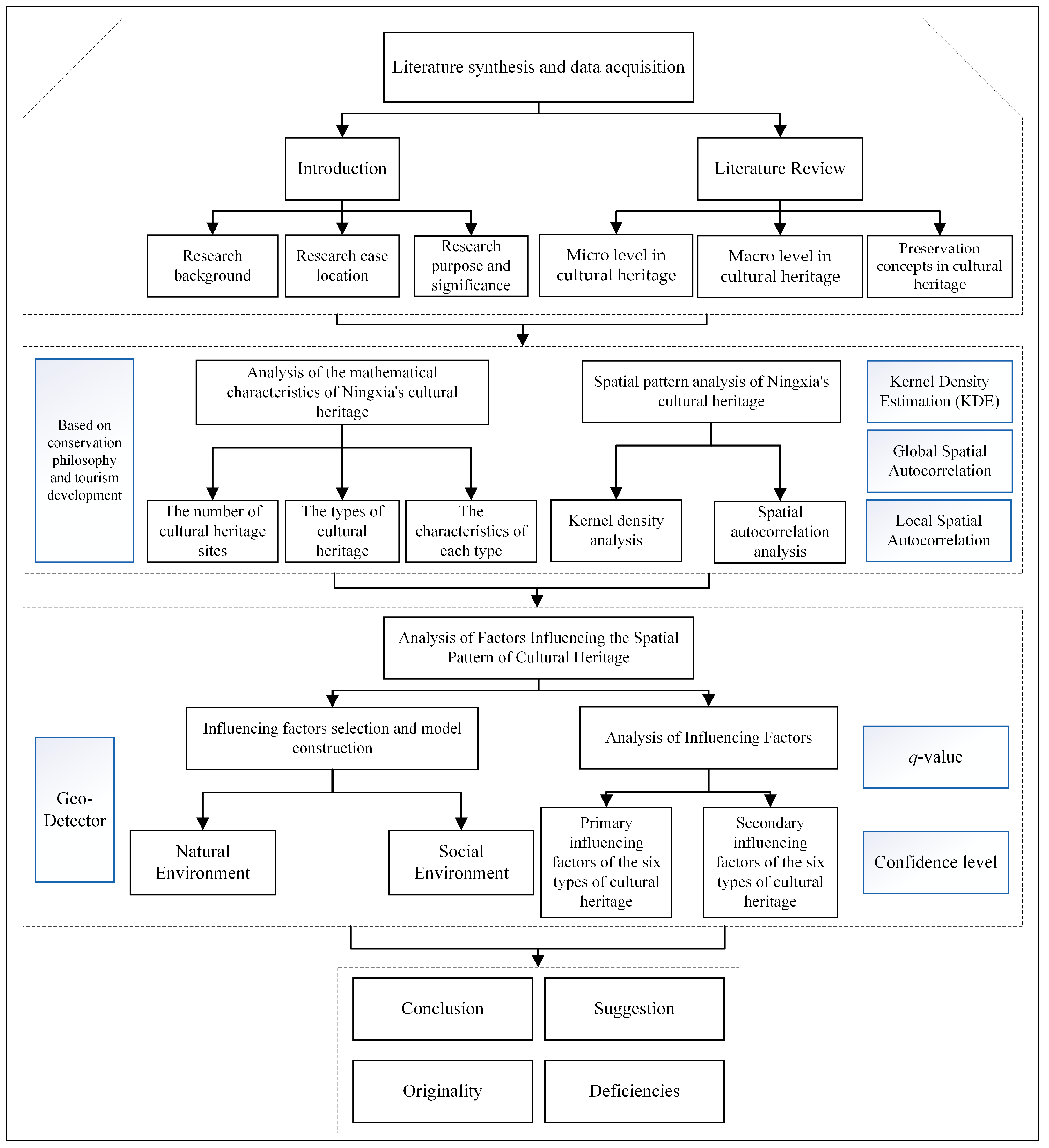
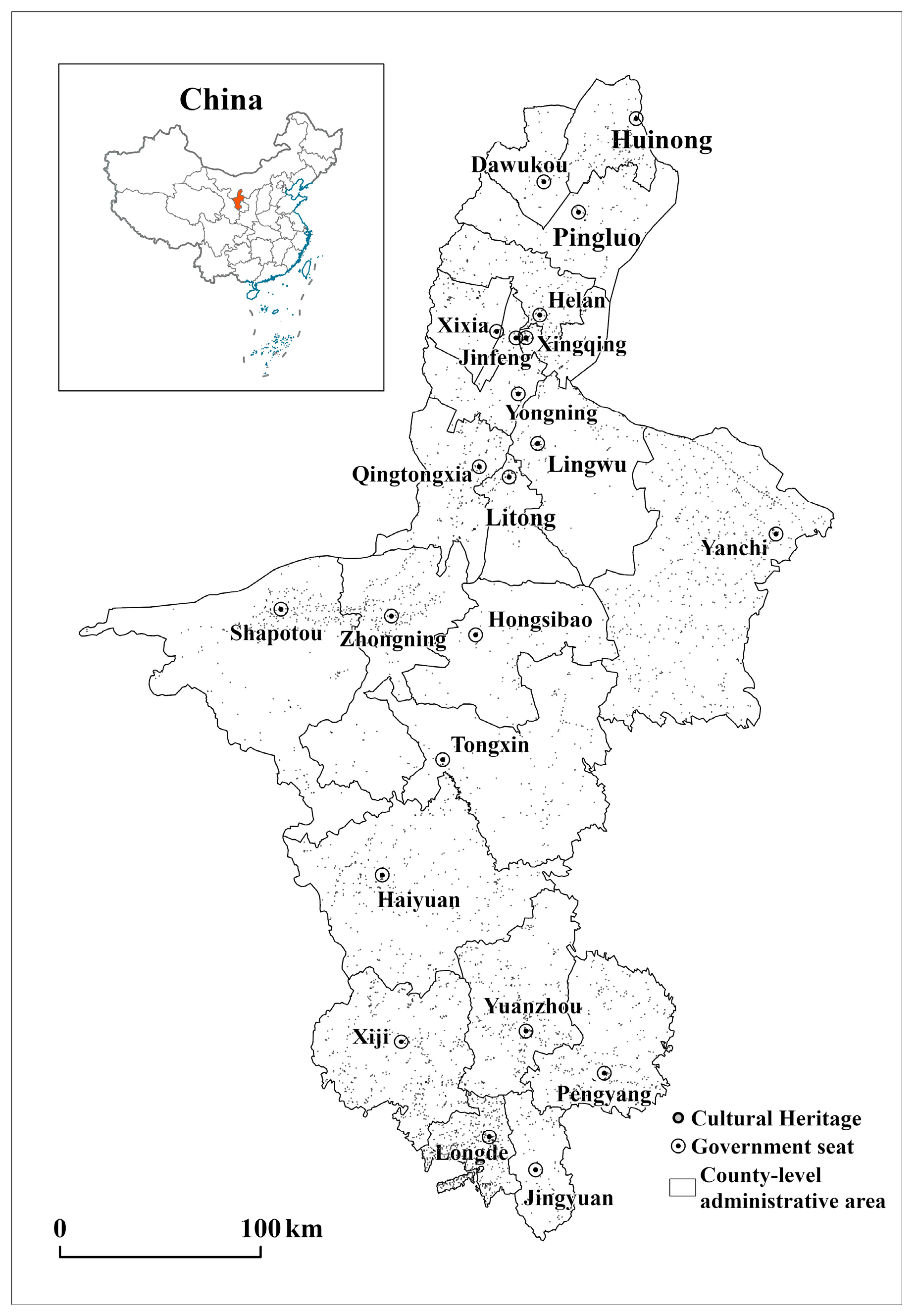

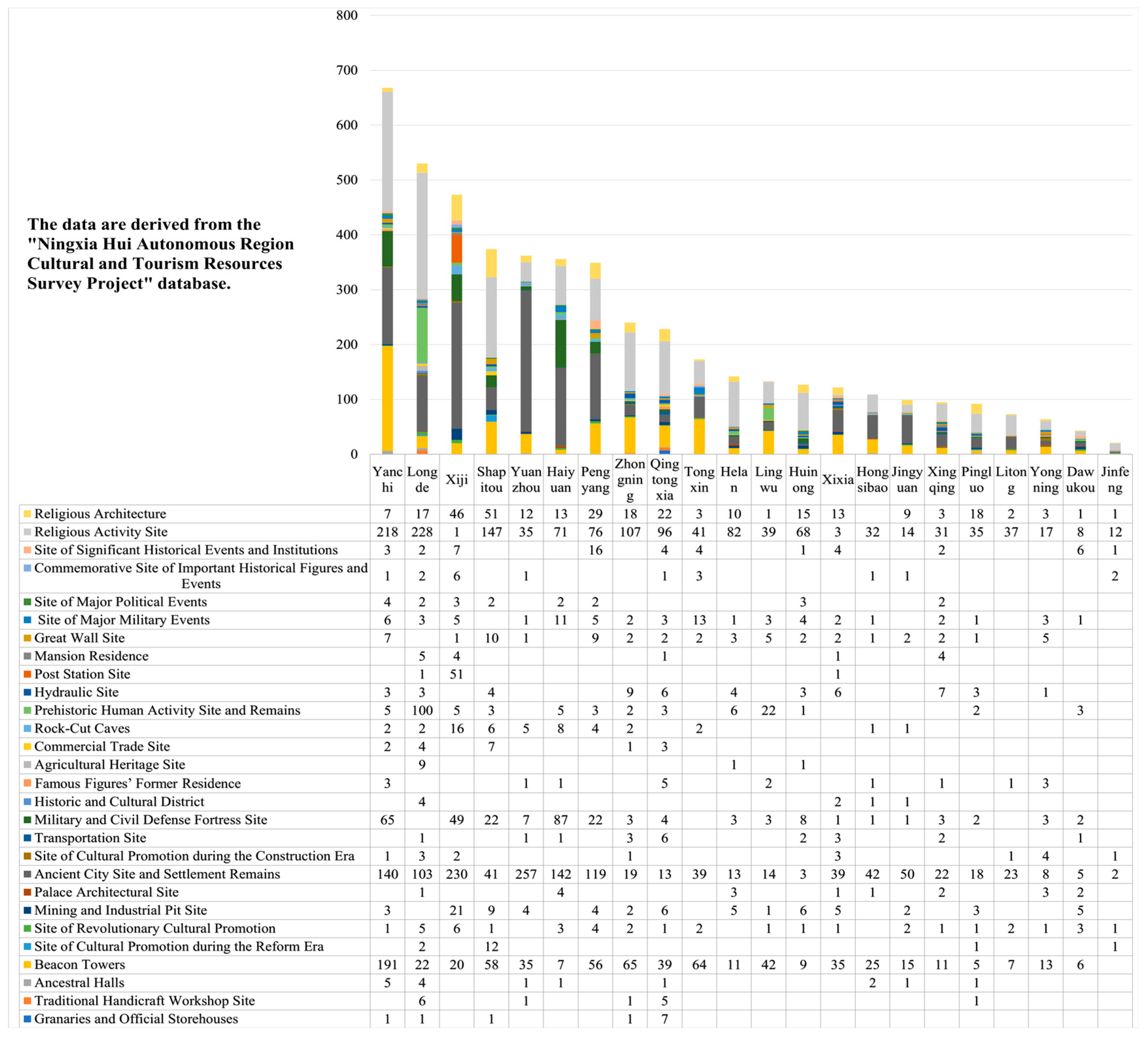
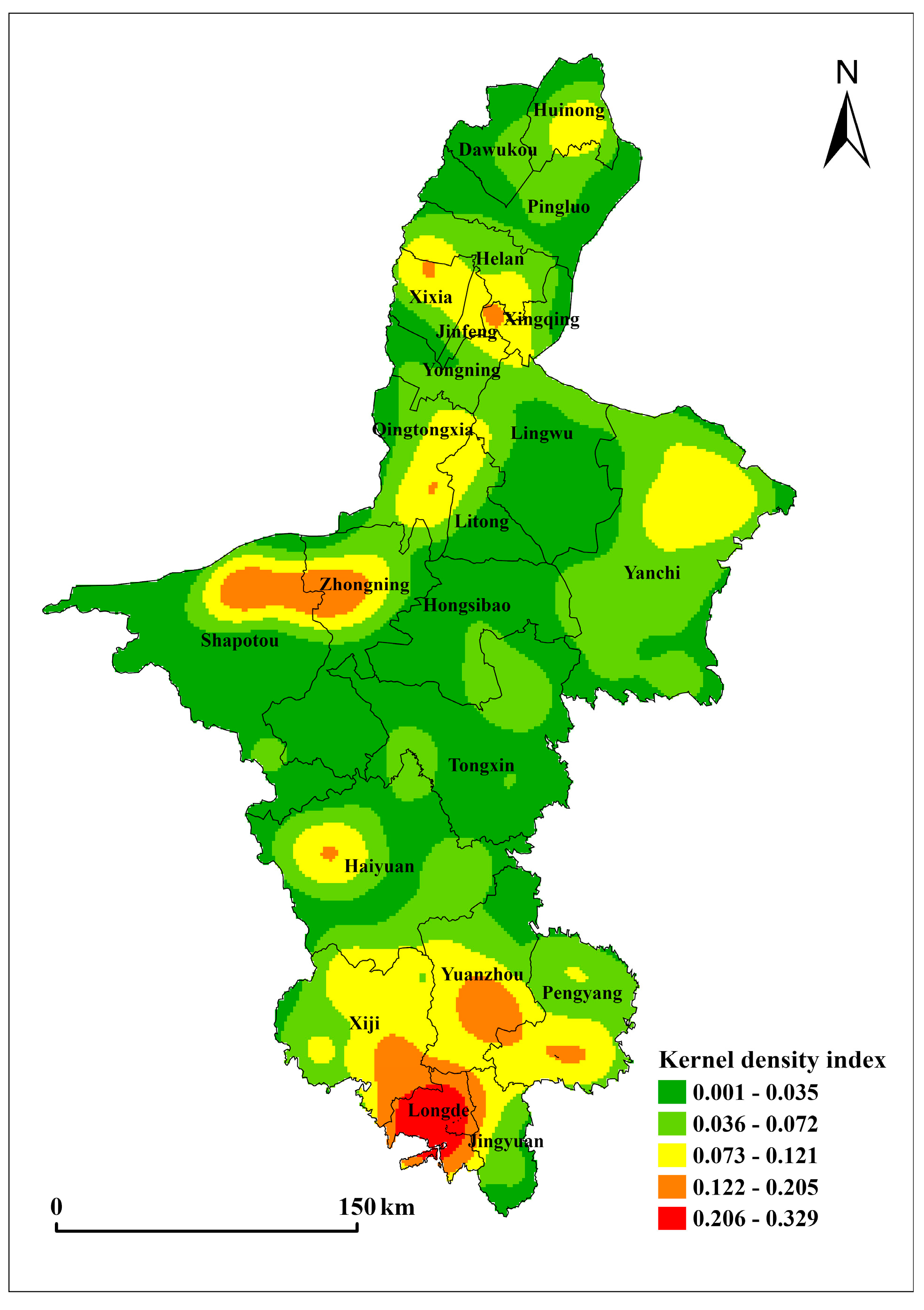
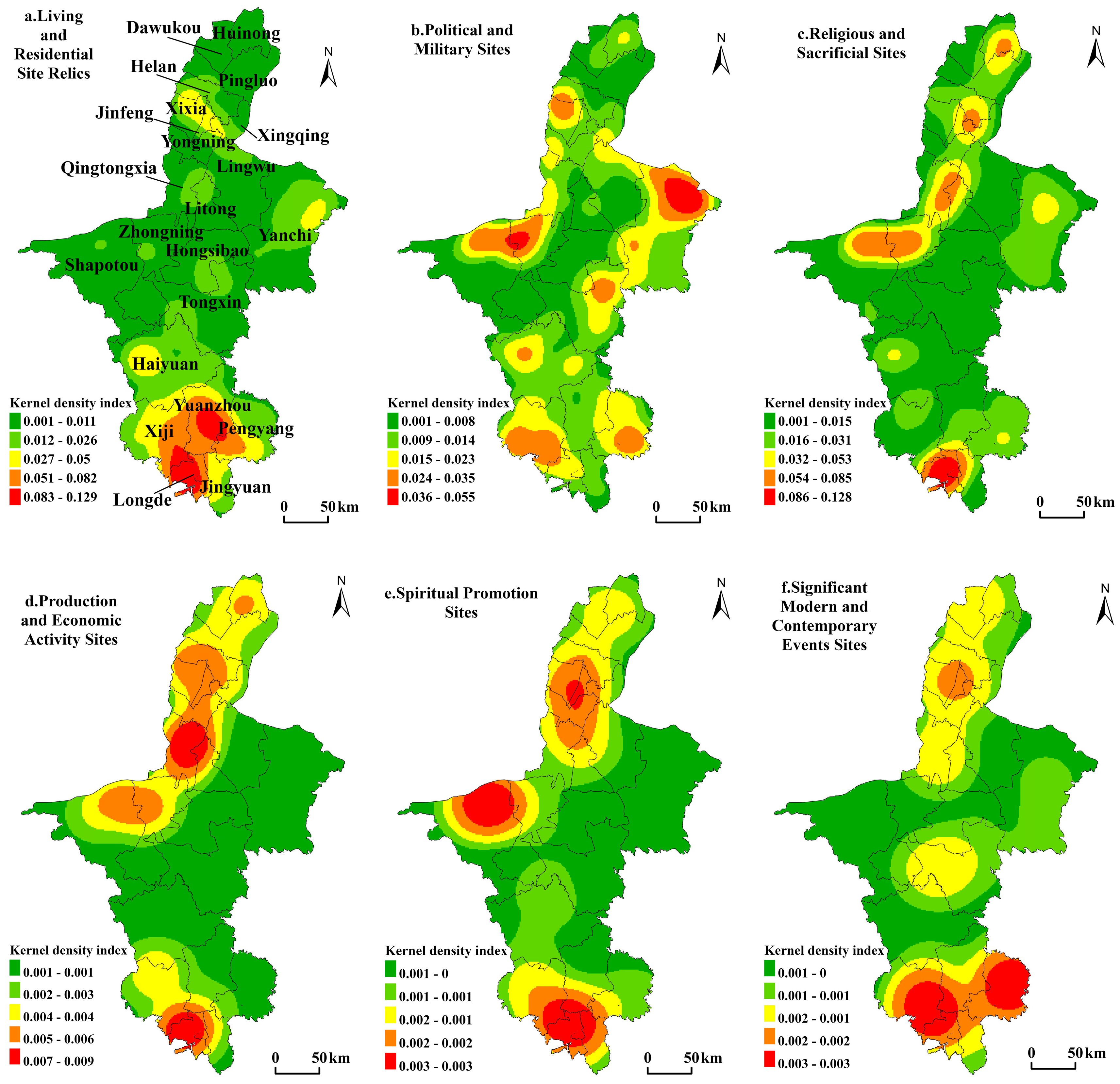
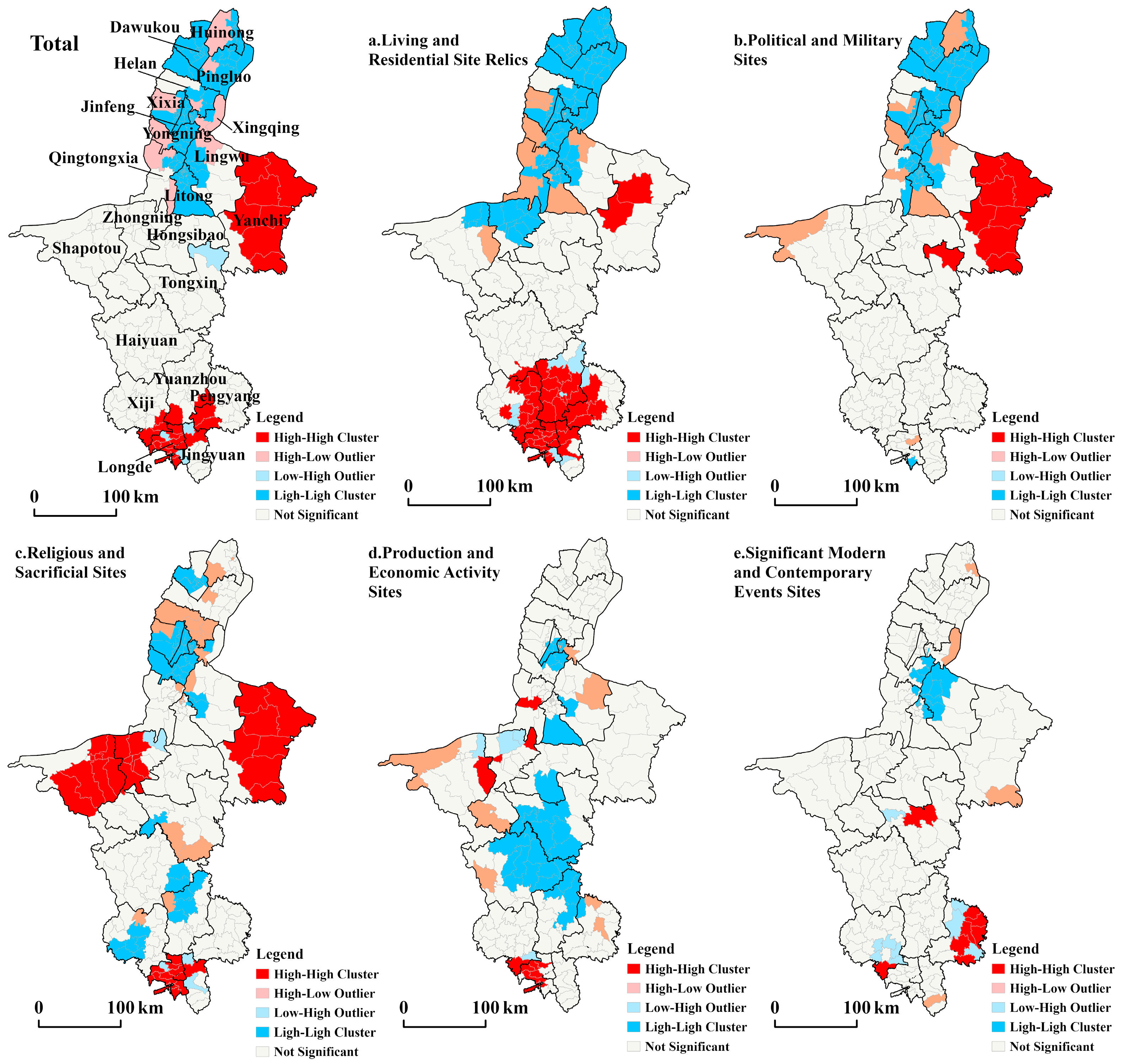
| Methodology | Fuction |
|---|---|
| Kernel density analysis | intuitively display the degree of spatial agglomeration of cultural heritage |
| Global spatial autocorrelation | describe the overall characteristics of the spatial distribution of cultural heritage and determine whether there is spatial clustering |
| Local spatial autocorrelation | precisely identify the specific locations of spatial agglomeration of cultural heritage, namely the “hotspot” or “cold spot” areas |
| Geo-detector | reveal the various influencing factors behind the spatial distribution of cultural heritage and their relative importance |
| Main Category | Subcategory | ||||
|---|---|---|---|---|---|
| Category | Amount | Percentage (%) | Category | Amount | Percentage (%) |
| Remains of living and residential sites | 1578 | 32.4% | Prehistoric human activity sites and monuments | 160 | 3.3% |
| Ancient City Sites and Settlement Remains | 1342 | 27.5% | |||
| Historic and cultural district | 8 | 0.2% | |||
| ruins of a palace building | 17 | 0.3% | |||
| former residence of famous person | 18 | 0.4% | |||
| Family residence | 15 | 0.3% | |||
| Ancestral hall | 16 | 0.3% | |||
| Political and military sites | 1219 | 25.0% | Places and sites of major political events | 20 | 0.4% |
| Places and sites of major military events | 67 | 1.4% | |||
| Great Wall site (monument) | 57 | 1.2% | |||
| Military and civil defence fortress sites (monuments) | 286 | 5.9% | |||
| Beacon mounds for beacons | 736 | 15.1% | |||
| site of a relay station | 53 | 1.1% | |||
| Sites of production and economic activities | 196 | 4.0% | Agricultural heritage sites | 11 | 0.2% |
| Industrial and mining pits and caves site | 76 | 1.6% | |||
| Transport site | 20 | 0.4% | |||
| Water conservancy site | 49 | 1.0% | |||
| Trade ruin | 17 | 0.3% | |||
| Government granary and treasury | 11 | 0.2% | |||
| Sites of traditional craftsmen’s workshops | 14 | 0.3% | |||
| Religious and sacrificial sites | 1741 | 35.7% | Religious buildings | 294 | 6.0% |
| Place of religious activity | 1398 | 28.7% | |||
| Rock cave | 49 | 1.0% | |||
| Sites and memorials of important events in modern times | 68 | 1.4% | Sites of important historical events and institutions | 50 | 1.0% |
| Sites commemorating important historical figures and events | 18 | 0.4% | |||
| Places for the promotion of spirituality | 71 | 1.5% | Site for the promotion of revolutionary culture | 39 | 0.8% |
| Sites for the promotion of building culture | 16 | 0.3% | |||
| Sites for the promotion of a culture of reform | 16 | 0.3% | |||
| Indicator | Moran’s I | Z-Value | |
|---|---|---|---|
| Categories | |||
| Total | 0.472 | 16.821 | |
| Remains of living and residential sites | 0.477 | 16.783 | |
| Political and military sites | 0.389 | 14.594 | |
| Sites of production and economic activities | 0.088 | 3.296 | |
| Religion and Places of Worship | 0.405 | 14.299 | |
| Sites and memorials of important events in modern times | 0.096 | 3.686 | |
| Places for the promotion of spirituality | 0.020 * | 0.850 | |
| System of Indicators | Detection Factors | Explanation of Indicators |
|---|---|---|
| X1: Altitude | Altitude of cultural heritage resources | |
| Natural factors | X2: Slope | Slope of cultural heritage resources |
| X3: Water distribution | Distance of cultural heritage resources from the nearest water system | |
| X4: Accessibility | Distance of cultural heritage resources from the nearest major road | |
| X5: Distance to major cities | Nearest distance of cultural heritage resources to prefecture-level municipal government sites | |
| Social factors | X6: Population density | Population density in prefecture-level cities |
| X7: Proportion of population belonging to Ethnic minorities | Percentage of ethnic minorities in prefecture-level cities | |
| X8: Urbanization process | Urbanization rate | |
| X9: GDP per capita | GDP per capita in prefecture-level cities |
| System of Indicators | Detection Factors | Overall Resources | Remains of Living and Residential Sites | Political and Military Sites | Sites of Production and Economic Activities | Religious and Sacrificial Sites | Sites and Memorials of Important Events in Modern Times | Places for the Promotion of Spirituality |
|---|---|---|---|---|---|---|---|---|
| Natural factors | X1: Altitude | 0.115 | 0.248 | 0.010 | 0.379 | 0.160 | 0.103 | 0.200 |
| X2: Slope | 0.012 | 0.071 | 0.004 * | 0.018 | 0.012 | 0.060 | 0.006 | |
| X3: Water distribution | 0.068 | 0.049 | 0.029 | 0.083 | 0.056 | 0.070 | 0.083 | |
| X4: Accessibility | 0.057 | 0.015 | 0.014 | 0.048 | 0.068 | 0.016 | 0.031 | |
| X5: Distance to major cities | 0.092 | 0.036 | 0.010 | 0.357 | 0.119 | 0.072 | 0.329 | |
| Social factors | X6: Population density | 0.228 | 0.506 | 0.076 | 0.087 | 0.020 | 0.550 | 0.164 |
| X7: Proportion of population belonging to Ethnic minorities | 0.067 | 0.149 | 0.063 | 0.075 | 0.012 | 0.029 | 0.145 | |
| X8: Urbanization process | 0.230 | 0.509 | 0.049 | 0.046 | 0.018 | 0.543 | 0.149 | |
| X9: GDP per capita | 0.231 | 0.512 | 0.097 | 0.051 | 0.021 | 0.489 | 0.155 |
Disclaimer/Publisher’s Note: The statements, opinions and data contained in all publications are solely those of the individual author(s) and contributor(s) and not of MDPI and/or the editor(s). MDPI and/or the editor(s) disclaim responsibility for any injury to people or property resulting from any ideas, methods, instructions or products referred to in the content. |
© 2025 by the authors. Licensee MDPI, Basel, Switzerland. This article is an open access article distributed under the terms and conditions of the Creative Commons Attribution (CC BY) license (https://creativecommons.org/licenses/by/4.0/).
Share and Cite
Zhang, S.; Hu, T.; Zhang, T.; Ju, H.; Wang, Y. Tourism Development of Cultural Heritage Resources Through Conservation Concepts: A Case Study of Ningxia, China. Land 2025, 14, 201. https://doi.org/10.3390/land14010201
Zhang S, Hu T, Zhang T, Ju H, Wang Y. Tourism Development of Cultural Heritage Resources Through Conservation Concepts: A Case Study of Ningxia, China. Land. 2025; 14(1):201. https://doi.org/10.3390/land14010201
Chicago/Turabian StyleZhang, Shengrui, Tianyi Hu, Tongyan Zhang, Hongrun Ju, and Yingjie Wang. 2025. "Tourism Development of Cultural Heritage Resources Through Conservation Concepts: A Case Study of Ningxia, China" Land 14, no. 1: 201. https://doi.org/10.3390/land14010201
APA StyleZhang, S., Hu, T., Zhang, T., Ju, H., & Wang, Y. (2025). Tourism Development of Cultural Heritage Resources Through Conservation Concepts: A Case Study of Ningxia, China. Land, 14(1), 201. https://doi.org/10.3390/land14010201







